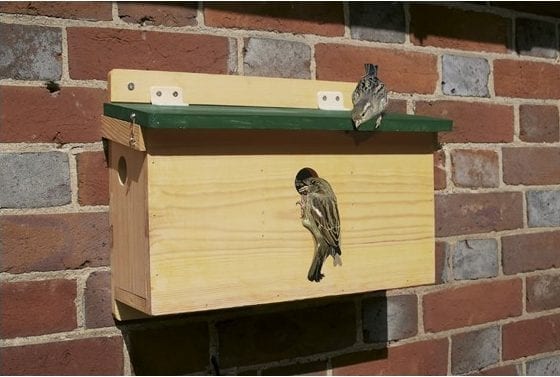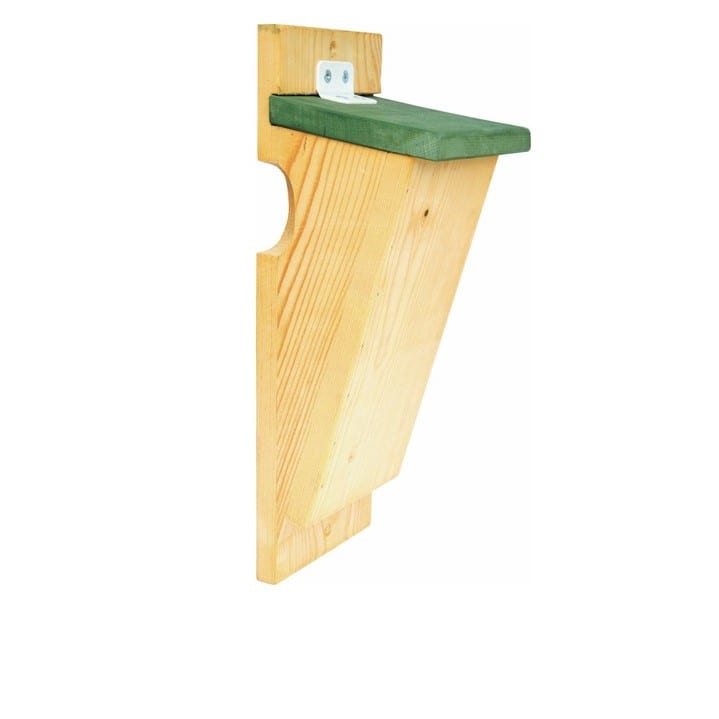Frequently asked questions about bird nestboxes and putting them up in your garden.
What birds will use my nestbox?
That depends on the type of nestbox you have. If you have a ‘traditional’ type of nestbox then it depends on the size of the entrance hole: Blue Tit and Coal Tit will use nestboxes with a 25mm diameter hole, Great Tit and Tree Sparrow will use it if it has a hole of 28mm and House Sparrows use nestboxes with entrances of 32mm diameter. House Sparrows will also used ‘terraced’ nestboxes – which are essentially two or three nestboxes joined together. Starlings will use nestboxes if they have an entrance of 45mm and are around 25-30% bigger than the average nestbox.
If you have an open-fronted nestbox then it might attract Blackbirds, Robins or Wrens to nest. Blackbirds require a mostly-open front, Robins are okay with something half open, and Wrens will use something a bit more closed up.
In addition to the ‘traditional’ style of nestbox there are specialist nestboxes available for species like Treecreeper, Jackdaw, Barn Owl, Kestrel, Grey Wagtail, Dipper, Swallow, House Martin and Swift.
See the BirdWatch Ireland shop here for a variety of different types of nestboxes.
How high should I put my nestbox?
Many people put their nestboxes up too high – really you want it 2-4m off the ground if it’s a nestbox with a hole. Something around 2m up should be fine once there’s no way for cats to get near it. The exception is for open-fronted nestboxes for Robins, Wrens and Blackbirds which should be lower than 2m but amongst dense vegetation and somewhere cats and other predators won’t easily see or access it.
If you’re attaching it to a tree, don’t drill or nail it as this will damage the tree, but instead use a wire strap wrapped around the tree.
How can I choose the right location for my nestbox?
Firstly, make sure it’s facing a direction where it’s not going to bear the brunt of wind, rain or strong sunshine – facing between north and south-east is usually best, though there’s some flexibility here if it’s in a sheltered corner of the garden/house. Tilt the box forward slightly so any rain will run off the top, and a nestbox with some small holes for drainage in the bottom are preferable too – just in case.
After that, somewhere with some surrounding vegetation (ivy, brambles, shrubs, trees) is ideal, but make sure the birds have a clear flight path to access the nestbox hole. For Starlings and House Sparrows (and occasionally other species), boxes placed under the eaves of your house or shed should work well.
Lastly – don’t put your nestbox beside where you feed your birds as any birds looking to nest will waste a lot of energy trying to fend off intruders into their territory!
How can I tell if my nestbox is being used?
The best way to tell if your nestbox is being used is to keep a watchful eye from as far away as possible. If you’re standing too close, the parent birds won’t want to give away the location of their nest to a potential predator (i.e. you!), so they won’t fly in. If you open the nestbox there’s a risk that the adults will abandon it – this can happen during nest construction, egg incubation and even chick raising, so don’t risk it! You should never take down a nestbox during the breeding season (i.e. start March – end September) as there may be birds using it without you knowing!
There are a variety of nestbox cameras on the market which allow you to see whats happening in your nestbox without disturbing the birds. See the BirdWatch Ireland shop here for some nextbox cameras.
Should I move my nestbox if its not being used?
It often takes a year or two before a nestbox is used, so don’t panic if there aren’t birds nesting in it straight away. If you’ve picked a good location for it then you’re better off leaving it where it is rather than moving it around from year to year. The longer it is in one place, the more the birds get used to it and are more likely to use it down the line. If it hasn’t been used after two years, then it might be worth changing location. Never move a nestbox during the breeding season (start of March to end of September) as there might be birds using it without you realising it!
During the cold winter months, many garden bird species will use nestboxes as somewhere to roost and shelter for the night, so it’s worth leaving your box out all year round.
What other species use nestboxes, apart from the usual garden birds?
There’s a variety of more specialist nestboxes available for species of farmland and river habitats, many of which are available here on the BirdWatch Ireland shop.
Treecreepers will use a special sloped nestbox design that mimics a crevice along the trunk of a tree where they would naturally nest. Swallows will use artificial nest cups when placed under the eaves of a house or inside a shed or porch, and there’s a slightly different design for House Martins for the outside of buildings too. If you have a river with Dippers or Grey Wagtails, there’s a custom nestbox that can be attached to bridges to give them somewhere to nest.
Swifts are a species declining in large part due to loss of nest sites in buildings, but by installing and incorporating nestboxes into buildings in towns and cities we can halt their decline. We’ve produced a comprehensive guide to saving swifts which can be downloaded here.
If you have Barn Owls or Kestrels in your area, there are specially designed nestboxes you can provide for these species, further information for which is freely available online.
When is the best time to put up a nestbox?
There’s an old proverb that says something along the lines of “The best time to plant a tree was 20 years ago, the second best time is now!” and the same can be said for nestboxes. If you can get them up in March there’s still a good chance they’ll be used that year, but the further in advance of spring the better.
If you put it up in the middle of the nesting season (summer months) it’s unlikely to be used until the following year as birds will have already established territories and found nesting sites. By putting it up well in advance of the following breeding season you’re giving your local birds a chance to find it, get used to it and check it out ahead of the following year. Also, small birds such as Wrens will often roost (i.e. sleep) in nestboxes during cold winter nights, as somewhere warm and sheltered – so it’s not all about nesting when it comes to nestboxes!
How can I build a nestbox for my garden birds?
Our Garden Birds nestbox guide provides a template and measurements for you to create a range of nestboxes for a number of common garden bird species including, Robins, Blue/Great Tits, Starlings and Spotted Flycatcher. Download the free Garden Birds nestbox PDF here.
How can I build a Barn Owl nestbox?
If you are interested in constructing a Barn Owl nestbox, BirdWatch Ireland has create a simple guide that walks you through the process. Download the free Barn Owl nestbox construction PDF here.
Our comprehensive Barn Owl booklet is another brilliant resource for anyone who wishes to learn more about Barn Owls. It includes practical information on things such as habitat enhancement and creation, rodenticide reduction, building indoor and outdoor nestboxes and finding a suitable location for your Barn Owl nestbox. Download the free Barn Owl booklet here.
Where can I buy a Barn Owl nestbox?
If you do not wish to make a Barn Owl nestbox yourself, there are a number of companies making and selling them online. However, unfortunately, some of these nest boxes are not of the ideal or appropriate design. One of the best websites for purchasing these boxes is Irish Garden Birds. They ship nationwide.
If you have a Barn Owl group in your county, they may also be providing nestboxes. If you are purchasing a Barn Owl nestbox, it is very important that you buy one that is fit for purpose. See our guide to Barn Owl nestboxes in this video.
 Nestboxes for Garden Birds (FAQ)
Nestboxes for Garden Birds (FAQ)
 Nestboxes for Garden Birds (FAQ)
Nestboxes for Garden Birds (FAQ)





